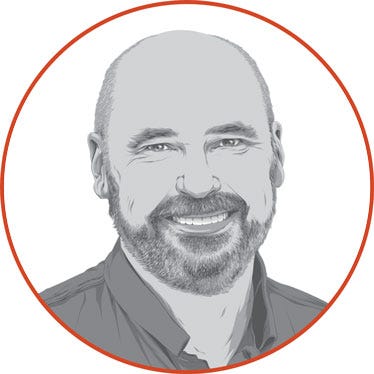
Let’s face it: David Fremark is a busy guy. Given he has some 18,000 acres, a 6,000-head feedlot, 3,000 cows, a trucking company and 20 to 25 non-family employees to look after, you might think this farmer would be keen to adapt new management tools to help him keep track of everyone.
And that’s where you’d be wrong.
“The people who work for me want to see me in person,” says Fremark, whose operation is based in St. Lawrence, S.D. “I want to look them in the eye and say, I need you to plant that field this deep, and at 4.2 miles an hour, because if you don’t, it could cost this business a lot of money.

“If you can get people who work for you to feel as passionate about their work as the owners, then you’re doing something right,” says South Dakota farmer David Fremark (l). Photos: Jaimi Lammers
“I can’t really make the same kind of impression on him through a work order that appears on his smart phone.”
Mind you, Fremark has smart phones, monitors on several of the farm’s 17 tractors, and office computers busily crunching numbers. Variable Rate Technology (VRT) is used for fertilizer and seed population on owned land, though it is too expensive to map all the leased land. Soil testing and mapping are used for VRT decisions.
Newer, cloud-based data tools can help farmers with everything from logistics to personnel management. It’s likely the services will grow as farmers become bigger and more sophisticated.
Still, Fremark says, there’s just something about talking to a person one-on-one.
The former college football player recalls a time when three young workers were planting corn for him, each set up with identical tractor/planter rigs. One of them seemed to be gobbling up acres at a pretty fast clip.
“I just thought he was working more hours,” Fremark recalls.

Fremark, left, manages up to 25 non-family employees on the 18,000-acre grain, trucking and cattle operation in South Dakota.
Then one day after delivering parts to the field, Fremark lingered to watch his young worker plant. “Watching, I see the tire lugs are a blur, and he’s cruising down the field at 7 mph plus,” Fremark recalls. “I got him stopped and explained that he had probably cost me 5 to 20 bu. per acre because of inaccurate seed placement in our no-till environment, which likely amounted to some $100,000 in lost yield from the fields where he had been planting too fast. He didn’t know. The planter operating manual said 4-8 miles per hour so why not go 7.5?”
The young man was, to say the least, crushed. But he loved working on the farm and eventually became one of Fremark’s top employees. Fremark is convinced that the behavior could only have been corrected with face-to-face communication – not a data-generated work order.
Building passion
Fremark’s 25 employees are mostly high school educated young people who get paid an hourly wage. Some make over $60,000 a year and are thrilled to be working on his farm. Why?
“I started with nothing and I got to where I am by making people believe in me and the goals of the farm,” he says. “If you can get people who work for you to feel as passionate about their work as the owners, then you’re doing something right.”
Fremark says his attitude was shaped long ago when he played middle linebacker and was captain of the South Dakota State University football team.
“People want to be a part of something bigger than themselves,” he says. “Once they have a sense of ownership of the livestock or equipment, all of a sudden it gets better care.”
In High School Fremark was the biggest and fastest kid on the team. Even so, he knew he couldn’t perform well unless the linemen blocking for him had good technique and motivation.
“To me, that translates from the playing field to the farm, because I can’t do it without them, without this team,” he says. ”I tell my employees every day, this doesn’t work without you guys. I couldn’t do my job without them doing theirs.”
He’s spent a lot of time thinking about how to motivate employees, especially with livestock, where the job requires more than just an 8-5 mentality.
Feeding calves on Christmas day
“A livestock guy gets up in the morning and he doesn’t know exactly what he’s going to do that day,” he says. “Someone’s got to be there for calving season all night, or feeding them on Christmas day. You can’t pay people enough to do those things, they have to have a desire to do that work. If you give them a feeling of ownership, they are working for themselves all the while they’re working for you.
“Ask anyone what’s most important and they’ll say they want the respect of their employer, then financial compensation,” he adds. “First, they want their efforts to be valued.”
Fremark was 25 when he hired his first employee. He realized he could hire someone to do a job so he could spend his time on higher-value tasks like managing the business.
“As my business grew, I had to spend more time with lenders, the FSA office, crop insurance,” he says. “I became a purchasing manager - buying inputs. Then a sales manager-- marketing, and more office time, enterprise analysis.
“Don’t get me wrong, I love to run a combine or work cattle. But I don’t do it much anymore. That’s why it’s important to communicate with the folks doing those jobs. They take on a new sense of pride when they realize that everything they do matters, and nothing translates that better than face-to -face communication.”
About the Author(s)
You May Also Like






